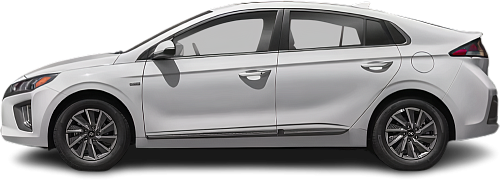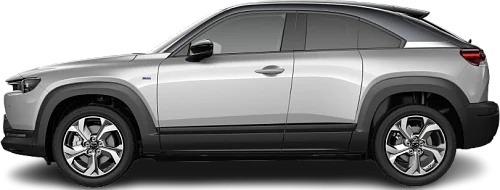Global EV Comparison: Hyundai Ioniq Electric Gen 2 vs Mazda MX-30 Electric
Struggling to Decide? Let AI Help!
Your AI Summary Is Ready!
General Info
The Mazda MX-30 Electric (2020-…) is currently produced, it has a starting price of €35990. The Hyundai Ioniq Electric Gen 2 (2019-2022) has been discontinued. You can find it for as low as €14900 on the used car market.
The Hyundai Ioniq Electric Gen 2 (2019-2022) is a Liftback, whereas the Mazda MX-30 Electric (2020-…) is a SUV.
| Property | Hyundai Ioniq Electric Gen 2 | Mazda MX-30 Electric |
|---|---|---|
| Years of Production | 2019-2022 | 2020-… |
| Current Status | Discontinued | Produced |
| Country of Manufacture | South Korea | Japan |
| Body Style | Liftback | SUV |
| Market Availability | EU, USA | EU, USA |
| Price Europe (New) | - Price Europe (New) | €35990 |
| Price Europe (Used) | €14900 | €13000 |
| GCC Score | 5 | 4.8 |
Range and Efficiency
The Hyundai Ioniq Electric Gen 2 (2019-2022) boasts a greater real-world range, a larger battery, and superior energy efficiency compared to the Mazda MX-30 Electric (2020-…).
| Property | Hyundai Ioniq Electric Gen 2 | Mazda MX-30 Electric |
|---|---|---|
| Range (EPA) | 274 km | 161 km |
| Range (WLTP) | 311 km | 200 km |
| Range (GCC) | 262 km | 161 km |
| Battery Capacity (Nominal) | 40.4 kWh | 35.5 kWh |
| Battery Capacity (Usable) | 38.3 kWh | 30 kWh |
| Efficiency per 100 km | 14.6 kWh/100 km | 18.6 kWh/100 km |
| Efficiency per kWh | 6.84 km/kWh | 5.37 km/kWh |
| Range and Efficiency Score | 6.4 | 4.5 |
Charging
Both vehicles utilize a standard 400-volt architecture.
The Mazda MX-30 Electric (2020-…) offers faster charging speeds at DC stations, reaching up to 50 kW, while the Hyundai Ioniq Electric Gen 2 (2019-2022) maxes out at 44 kW.
The Mazda MX-30 Electric (2020-…) features a more powerful on-board charger, supporting a maximum AC charging power of 11 kW, whereas the Hyundai Ioniq Electric Gen 2 (2019-2022) is limited to 7.2 kW.
| Property | Hyundai Ioniq Electric Gen 2 | Mazda MX-30 Electric |
|---|---|---|
| Max Charging Power (AC) | 7.2 kW | 11 kW |
| Max Charging Power (DC) | 44 kW | 50 kW |
| Architecture | 400 V | 400 V |
| Charge Port | CCS Type 2 | CCS Type 2 |
| Charging Score | 3.9 | 4.3 |
Performance
Both vehicles are front-wheel drive.
Both cars deliver the same 0-100 km/h acceleration time, but the Mazda MX-30 Electric (2020-…) boasts greater motor power.
| Property | Hyundai Ioniq Electric Gen 2 | Mazda MX-30 Electric |
|---|---|---|
| Drive Type | FWD | FWD |
| Motor Type | PMSM | PMSM |
| Motor Power (kW) | 100 kW | 107 kW |
| Motor Power (hp) | 134 hp | 143 hp |
| Motor Torque | 295 Nm | 271 Nm |
| 0-100 km/h | 9.7 s | 9.7 s |
| Top Speed | 165 km/h | 140 km/h |
| Performance Score | 2.9 | 2.6 |
Dimensions
The Mazda MX-30 Electric (2020-…) is taller, but has a similar length and width to the Hyundai Ioniq Electric Gen 2 (2019-2022).
Both models have similar wheelbase lengths.
| Property | Hyundai Ioniq Electric Gen 2 | Mazda MX-30 Electric |
|---|---|---|
| Length | 4470 mm | 4395 mm |
| Width (with Mirrors) | 2045 mm | 2035 mm |
| Width (w/o Mirrors) | 1820 mm | 1795 mm |
| Height | 1450 mm | 1555 mm |
| Wheelbase | 2700 mm | 2655 mm |
Cargo and Towing
The Mazda MX-30 Electric (2020-…) features a larger trunk, but the Hyundai Ioniq Electric Gen 2 (2019-2022) offers greater maximum cargo capacity when the rear seats are folded.
Neither car is equipped with a frunk (front trunk).
Neither vehicle is officially rated for towing in in the EU.
| Property | Hyundai Ioniq Electric Gen 2 | Mazda MX-30 Electric |
|---|---|---|
| Number of Seats | 5 | 5 |
| Curb Weight | 1602 kg | 1720 kg |
| Cargo Volume (Trunk) | 357 l | 366 l |
| Cargo Volume (Max) | 1417 l | 1171 l |
| Cargo Volume (Frunk) | - Cargo Volume (Frunk) | - Cargo Volume (Frunk) |
| Towing Capacity | - Towing Capacity | - Towing Capacity |
| Cargo and Towing Score | 4.1 | 5.5 |




